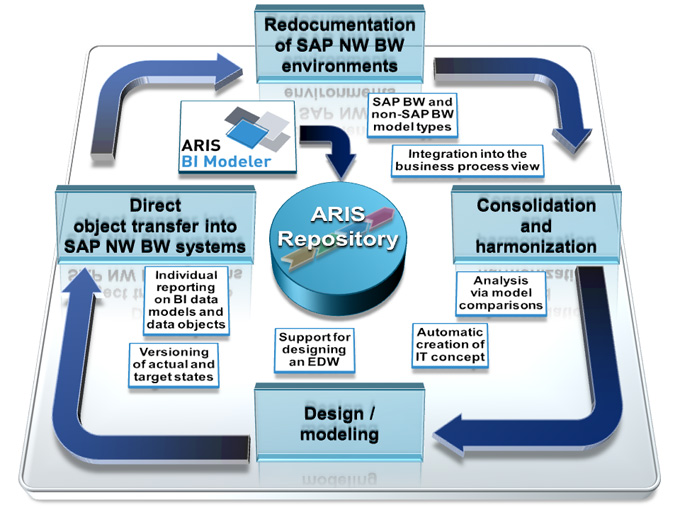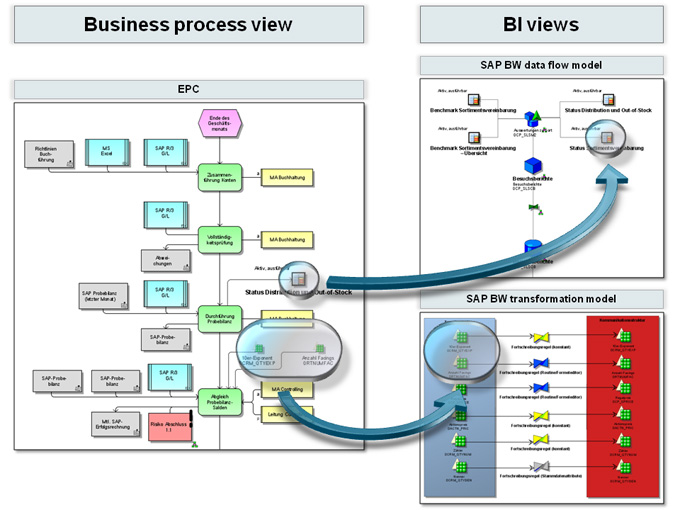In the last time a saw an interesting Expert Paper from Oliver Raths and Harry Enns about Business Intelligence (BI) and ARIS, which I don’t want deny you. I think it’s new and therefore I give you a short summary of that.
BI experts know enterprise-wide BI system environments are growing ever larger and typically more complex. Mergers and acquisitions are also driving a rising tide of redundant BI systems as markets and businesses undergo radical changes. Organizations now have to adapt their business strategy and corporate objectives at increasingly short intervals, giving rise to a steady succession of new or modified business processes. This in turn necessitates new cross-company and department-specific key performance indicators (KPIs), data flows, and data structures. Many companies operate separate BI solutions for individual divisions or national subsidiaries. The consequence is often multiple reporting structures within an SAP NetWeaver Business Warehouse (SAP NW BW) system or, not infrequently, a diverse BI environment comprising multiple BI systems, each designed to meet the specific needs of an operational unit.
Redundancies between loading processes and data records mean higher costs for operation, maintenance, development, software licenses, and hardware. Harmonizing and consolidating multiple BI systems is therefore imperative. Graphics software and text processing programs are still widely used in the concept phase, which makes versioning difficult. Lack of support for separate development and production environments, distributed working practices, database-oriented analysis, and actual comparisons is another weakness of this kind of approach. A tool that aims to provide better visibility into existing BI systems and thus improve identification of potential savings must enable the following:
- Redocumentation of disparate SAP NW BW systems as the basis for further design and analysis
- Consistent, comprehensible documentation of data flows and structures across the entire BI environment
- Clear overview of BI information in detailed and aggregated views
- Integrated, method-based modeling of BI data flows/structures
- Faster identification of harmonization and consolidation potential of multiple SAP NW BW systems
- Integration of BI information into the business process view
- Support for designing an Enterprise Data Warehouse (EDW)
- Audit-proof versioning of different BI system states
ARIS BI Modeler is an integral component of IDS Scheer’s proven ARIS Platform and delivers a host of functions to bring transparency to existing BI systems. IT staff, BI experts, and departmental employees benefit from a powerful tool for handling redocumentation, design, and modeling tasks as part of projects to introduce, harmonize, or consolidate BI. A consistent and methodical approach to analyzing and redocumenting the existing SAP NW BW environment that delivers transparent results based on business needs paves the way for planning, designing, and implementing an optimized EDW.
Redocumentation of the specific SAP models contained in ARIS BI Modeler involves adding the technical metadata of the existing SAP NW BW systems and provides multiple views of BI data flows and structures. These views are fully integrated into the central ARIS Repository and enable analysis of an aggregated, strategic view of overall data flows and of a detailed view of the data structures throughout the entire BI environment. A comprehensive representation of the data flows in SAP NW BW 7.0 and SAP NW BW 3.5 is included. Non-SAP models are also provided for designing non-SAP applications.
ARIS BI Modeler supports the entire concept phase, from creating and refining the original concept to implementing SAP NW BW environments. Thanks to a uniform, integrated modeling methodology, IT and user departments benefit from having the same design view. As well as enabling faster project implementation and processing of change requests, this shared BW understanding allows a more flexible response to business process changes and facilitates prompt handling of user department requirements. In addition, prototypes can be created more quickly for decision-making purposes. Redocumentation of existing SAP NW BW data flows and structures provides a platform for further design and modeling, with the generated views enabling end-to-end modeling of process-related strategic and operational requirements. The central ARIS Repository delivers the BI information required for design work, which can be reused on a modular basis. Thanks to its integration into the central ARIS Repository, ARIS BI Modeler has direct access to the process descriptions in ARIS Business Architect for SAP and is thus the starting point for making BI information part of a holistic Business Process Management system. This enables assignment of process relationships to the technical database relationships of the BI system.
Business processes can be enriched with BI information via the central ARIS Repository and seamlessly integrated into existing process modeling. The various BI views receive direct information about the origin of the data from the business processes. Linking SAP BW data flows with business process descriptions creates transparency based on business requirements. It is possible to assign responsibility for specific BI objects via the link with business processes. All the relevant data and information contained in the SAP NW BW system can be identified, analyzed, and designed based on the roles and responsibilities of the employees, the business processes, and the associated information needs.
ARIS BI Modeler adds significant value and achieves long-term savings in the operation of your BI environment. Its functionalities support structured planning, design, and implementation of BI system environments and optimize introduction of an EDW. The result is faster startup and comprehensive tracking of BI projects. Automatic redocumentation of SAP Business Content and generation of detailed strategic views serve to accelerate both prototype creation and the design phase. Analysis options provided by graphical model comparisons enable more efficient implementation of consolidation projects and identification of scope for harmonization.
Are you interested in the complete Expert Paper? Please download the file here. A small visual overview you find here.
Do you have experiences in the context of BI or valuable hints for using EDW or SAP NW BW? I look forward to discuss your posted comments.





